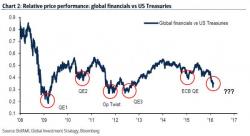Broad Market Index Testing Broken "Must Hold" Level

Via Dana Lyons Tumblr,
The broad NYSE Composite stock market index is testing the level we deemed “must hold” – that broke in January.

Via Dana Lyons Tumblr,
The broad NYSE Composite stock market index is testing the level we deemed “must hold” – that broke in January.

Authored by GlobalGold's Claudio Grass, via Acting-Man.com,
With a Gloomy Start to 2016, a Bust Seems just Around the Corner
Markets have corrected substantially since the beginning of the year as most of the gains of the past two years have been erased. According to Bloomberg, 40 out of the largest 63 markets have dropped over 20%. The image below shows the performance of markets word-wide since their most recent peaks. Most markets are in a bear market phase or are at best experiencing a strong correction. The world is red!
Authored by John Coumarianos, originally posted at MarketWatch.com,
One view of what caused the Great Depression in the 1930s is that the Federal Reserve failed to prevent a collapse in the money supply.
This is the famous thesis of Milton Friedman’s and Anna Schwartz’s A Monetary History of the United States, 1867-1960, and it was, more or less, the view of Ben Bernanke when he was chairman of the Federal Reserve.
The global economy today resembles that of the 1930s in several ominous ways.

Any time the relative performance of global financials to US Treasuries has stumbled as far as it has, as shown in the chart below, it has meant one thing - a major central bank intervention was imminent.
At least that's the interpretation of BofA's Michael Hartnett, who shows that in order to provide the kick for the bounce in this all too important "deflationary leading indicator", central banks engaged in major unorthodox easing episodes, whether QE1-3, or the ECB's QE.
Why intervene now? Here are the problems according to Hartnett:
Authored by Paul Craig Roberts,
The US economy died when middle class jobs were offshored and when the financial system was deregulated.
Jobs offshoring benefitted Wall Street, corporate executives, and shareholders, because lower labor and compliance costs resulted in higher profits. These profits flowed through to shareholders in the form of capital gains and to executives in the form of “performance bonuses.” Wall Street benefitted from the bull market generated by higher profits.